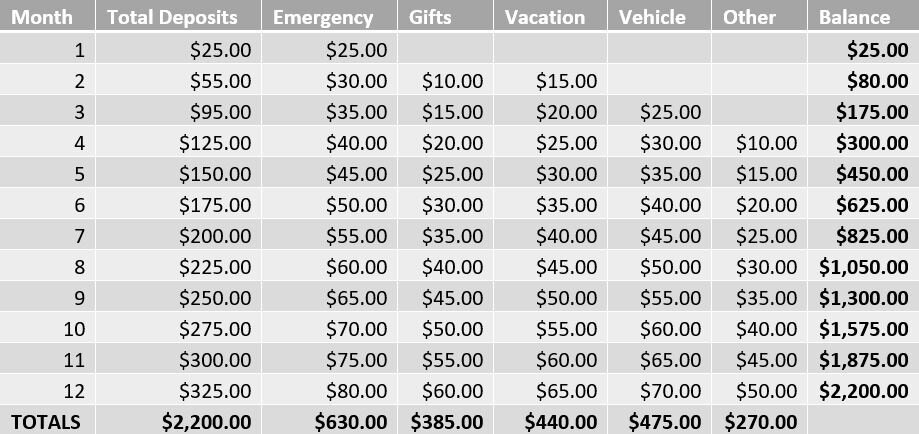Protect Your Future by Building an Emergency Savings Fund
“Pay yourself first!” This is the number one most important rule most financial experts try to get across to those working with them. Yet, across this country, a large majority of households do not pay themselves at all on a regular basis. In fact, even many adults attending personal finance workshops ask what “paying yourself first” really means.
One of the most important things you can do to strengthen your financial future is one of the most common and early learned personal finance principles, to save money, however, according to gobankingrates.com, 69% of adults in the United States have less than $1,000 in savings.
This means that almost 70% of the US adult population would have difficulty paying for mid-sized vehicle repairs, purchasing worn-out or broken home appliances, or paying for an unexpected medical emergency.
While we are going to focus on building an Emergency Savings Fund in this article, keep in mind that there are two separate personal savings funds that we should work towards building. One is for needs (Emergency Savings Fund) and the other is for wants (Standard Savings Account) and both are all too often neglected, as highlighted by the scant contributions made to even one savings account, let alone two.
It also means the majority of adults in the United States have little room for any loss of income. Even a temporary setback could lead to severe financial constraints. Things that could be deemed fairly harmless may lead an individual to take drastic action such as filing bankruptcy, getting a second job, or borrowing money at extremely unfavorable terms.
Instead of paying high-interest rates, attorney fees for filing bankruptcy, the physical or mental toll of having to work a second job, take the time to put yourself first by paying yourself first, you’ll find yourself in a much healthier position.
What does “Pay Yourself First” Mean?
To pay yourself first means to put money aside in a personal saving account for emergencies before you pay any other bills with your paycheck. It means that you should consider a transfer of money from your checking to your emergency savings fund to be the first bill you pay every payday.
If you do not pay yourself first but are living paycheck-to-paycheck like 60% to 80% of the general US adult population, you should reconsider what a payday means. If your entire paycheck goes to paying bills and expenses, then it is not your payday. It is everyone else’s payday. You do not get paid until you start to save money for yourself and for your future. That is savings.
Everyone knows you should have an emergency savings fund, but as we can see, very few build one. The key is getting yourself into the habit of saving money. It isn’t about the amount of money saved, it’s about creating a routine of saving money. The balance will grow over time.
Checklist for Building Your Emergency Savings Fund
☐ Make the Commitment. Savings is, above all else, a commitment and a state of mind. Commit to yourself that no matter the amount, you will save a small percentage or even a couple of dollars. Initially, the amount is less important than the consistency.
☐ Set a Goal for Consistency. While a long-term goal may be to save 10% to 15% of your monthly paycheck and ultimately have a savings account balance equal to three- to six months’ worth of living expenses, start by setting a goal to some something from every income source for the next three months. The amount does not need to be more than a few dollars if you feel savings is impossible. Once you establish your consistency, you can focus more on the number of your contributions.
☐ Find the Right Institution. Research banks and credit unions in your area as well as online. Choose the one you are comfortable with, but do not link your current checking and your new savings accounts electronically. Most households will be more successful savers if they keep their checking and savings at separate banks and credit unions. Otherwise, you may be tempted to transfer savings money back into your checking mid-pay period to cover unexpected wants rather than leaving the money in your savings for expected needs in the future.
☐ Set up the Accounts. If you already have a savings account set up, you may still want to use this step to set up the right number of savings accounts for your needs. Identify your account needs. You should consider having one saving account for emergency funds (you will live on these funds if you lose income), another for gift giving (e.g. Christmas and birthdays), another for vehicle repair and replacement, and another for vacation and travel, another for replacing furniture and appliances. You may open an additional account for other personal and household goals you choose to set.
☐ Automate the Transfers. Using either your employer’s direct deposit option or your bank’s automatic transfer scheduler, set up dollar amounts to automatically transfer into your savings accounts from the previous step. If your savings accounts are at a financial institution separate from checking, you might consider using your bank’s free bill pay option.
Can’t Find Money to Save? Try Looking a Bit Deeper
Many households with steady income believe they have no money to save. If this is the case in your home, revisit the very first step. If you have committed to saving money, it is because you recognize that you will have times in the future when you will need money, not just want to spend it. These future needs are more important to you than your current or future wants. If you feel your paycheck is already 100% spoken for, you might revisit the following types of expenses to redirect to your future needs:
Expenses that Are Fully or Partially Redirectable to Savings (or Preventable)
-
Dining out
-
Cable or satellite TV
-
Cell phone monthly financing
-
Cell phone plans with the most expensive services
-
Undisciplined grocery spending
-
Overspending on unnecessary clothing
-
Excessive vacationing
-
Large car payments
-
What else can you identify as something you could redirect to more important purchases in your future?
Sample Emergency Savings Plan by Month

You may think this looks impossible given that it goes from $25 in month one to $325 in month 12. Remember that you will likely be spending some of these savings during the year anyone. For example, a birthday might be around the corner. This year, though, instead of putting it on credit cards and paying interest on top of the purchase price of the gifts, you will use your savings and pay in cash. The same can be said about car maintenance (e.g. oil changes) or even your co-pay for an emergency room visit.
When to Use Your Emergency Savings Fund
Any time a necessity (Item of Need, not Want) comes up, you can use the emergency savings to cover it. If you’re new to saving money, you may find that it’s taking more time than you had anticipated. That’s okay, as long as the habit of saving money is there, the balance will grow over time.
Starting Small
Even if you start as small as $5 a month, once you set up an automatic transfer into your savings, you’ll find that at the end of the month, it made no noticeable difference in your spending, so you can double it to $10 the next month. In the third month, transfer an additional $10, so that you’re at $20 that month. Pretty soon, if your household is like most, you’ll find that you’re saving $100 to $200 a month, and don’t miss it.
Successful savings happens at the beginning of the month, not the end.
Just be sure that you use the emergency savings fund for things you need to pay for. If you tap into it when you want to take a vacation, or put money down on a new ATV, you’ll find yourself in the same boat, over and over again when emergencies occur. For those items that you want or would like to acquire you can rely on a basic savings account that has fewer restrictions on using it, essentially, if you don’t have the savings for the item, you wait until you do.
How Much Emergency Savings is Enough
Since emergency savings are needed for covering high-impact items like unexpected medical bills, loss or reduction of income, and vehicle or home repairs, you’ll need to save a sizeable amount in order to consider enough. Most financial experts agree that an individual should have enough money to cover at least three to six months of expenses.
While that may seem like a lot, you can get there sooner than you think. However, you are certainly unable to get there if you never start saving money into an emergency fund. There are numerous resources available online, and through various banking institutions, that can help you get organized and started. As always, if you have any questions and would like to speak to someone about your situation, we invite you to call and speak with a Certified Credit Counselor.



